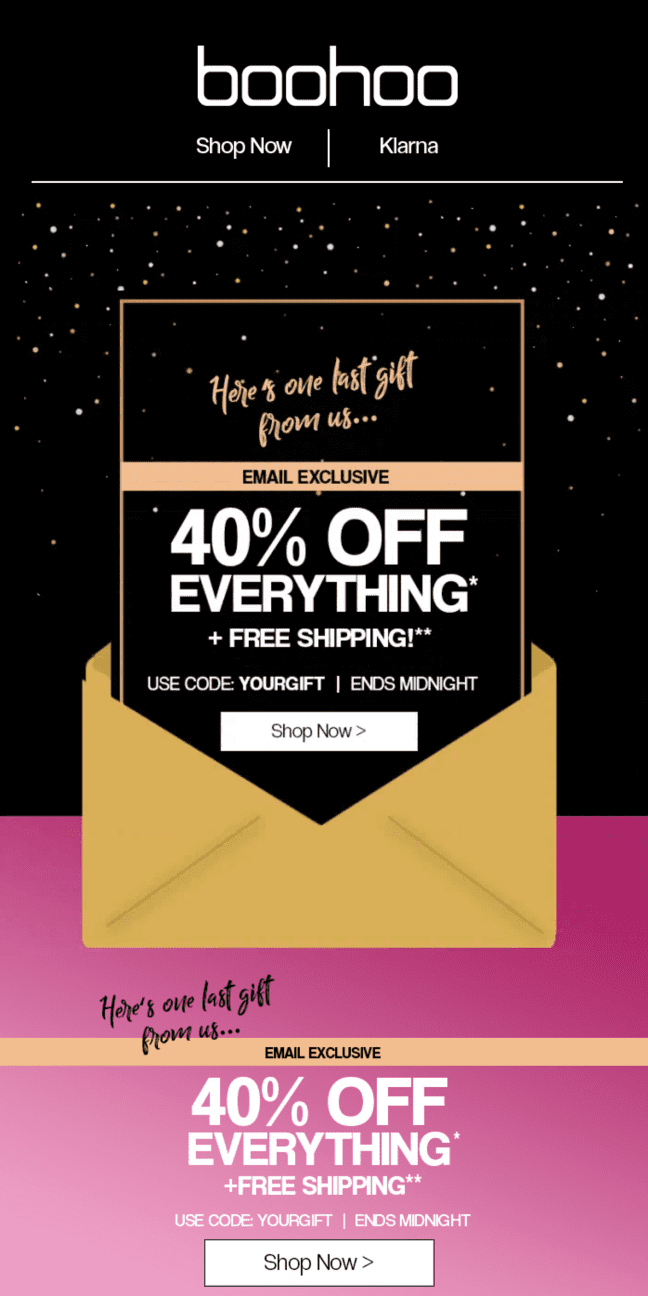What does your Boxing Day strategy look like?
If you live in the U.K. or Commonwealth countries, like Canada, Australia, or New Zealand, your plans for the Dec. 26 shopping extravaganza are either locked down already, or you at least have some sort of idea, but you’ll think about it after you get through Black Friday, Cyber Monday, Christmas and all the other emails in between.
In the United States, Boxing Day barely registers (unless your customers are Brit expatriates or devotees of “Downton Abbey”). So, it doesn’t figure into many e-commerce email marketing plans, aside from some brands with a cross-border audience.
Boxing Day’s significance as a shopping driver has fallen over the last couple of years, but it could get more oomph this year thanks to fortuitous timing (it falls on a shopper-friendly Saturday) and the boom in digital shopping thanks to the pandemic.
If Boxing Day is part of your plan—or you need a fresh theme to make your post-Christmas emails stand out in the inbox—now is a good time to create a memorable campaign that could get you closer to achieving your 2020 business goals.
What Is Boxing Day?
Boxing Day has several origin stories, but these are two of the most common traditions:
- Churches opened their alms-collection boxes and distributed the monies to the poor.
- Wealthy families presented gift boxes (or packaged-up holiday leftovers, or money) to their house staff, or businesses gave their employees gifts and the day off (unless you worked for Scrooge & Marley).
However you define it, Boxing Day is part of the cultural zeitgeist in many parts of the world. It’s a bank holiday in the U.K., a statutory holiday in Canada and one of the National Public Holidays in Australia—meaning banks, offices and schools are closed. In the past, it was a big in-store shopping day, but that could be different this year.
Why Boxing Day Could Be Bigger in 2020
Although Boxing Day remains a major shopping day, it has lost some ground to Black Friday in recent years. In 2019, a SimilarWeb analysis found total traffic on Boxing Day to the top 100 shopping sites in the U.K. declined by 6% from 2018. Visits that went past the landing page and were more likely to contribute to a conversion fell 13% in 2019.
SimilarWeb attributed that decline to uncertainty over Brexit and December parliamentary elections. Boxing Day also fell on a Thursday.
This year, however, Boxing Day is on Saturday, so the official holiday is observed on Monday. That gives shoppers more time to hunt for bargains and potentially extends your Boxing Day campaigns by a couple of days.
Also, digital shopping is predicted to grow in 2020 thanks to the combination of renewed lockdowns and other restrictions in the U.K. and Canada, and a continued reluctance by consumers to shop in stores.
5 Quick Tips for Better Boxing Day Emails
Many e-commerce email campaigns for Boxing Day follow a Black Friday format, beginning with a preview email sent the day before, timed offers throughout the day and a “last chance” campaign sent the following day. Aggressive bargains lead the message.
These tips can help you tune up your present Boxing Day strategy or introduce the concept to a new audience.
1. Look at past shopping habits to time email sends
SimilarWeb’s analysis found Boxing Day traffic generally parallels Black Friday. It starts to grow early in the morning, peaking first around noon, then mid-afternoon and a final surge in early evening.
Use what you know about customer shopping habits to do some real-time testing around email send times. If you don’t have Boxing Day history to draw from, Black Friday shopper behavior could be your guide.
The retailer boohoo U.K. sends campaigns throughout the day, matching SimilarWeb’s traffic patterns. The email below is the brand’s closing campaign of the day, framed as the “last gift” and using animation to highlight the offer and expiration.


boohoo U.K. uses animated email to signal the end of its Boxing Day campaign. Image via MailCharts
2. Put bargains in the spotlight
People have gift cash and cards to spend. Retailers have to clear out merchandise before the end of the fiscal year. It’s a match made in bargain-hunting heaven.
So, don’t be coy about your offers. But your message still has to stand out in a noisy inbox, and that’s what this Reitmans message does well.
The subject line doesn’t mince words: “🔥Up to 70% off? AND 10% on top? Sale’s heating up.” Inside, the leadoff reverse bar and email header restate the expected discounts, while product images throughout the message list actual discounts to drive clicks.


Reitmans mixes percentage-off discounts with specific price reductions to encourage click-throughs. Image via MailCharts
3. Consider flash sales, countdown timers and real-time updates
With most shoppers off either on Boxing Day itself or the following Monday when it will be observed this year, they might be more likely to be in shopping mode throughout the day. Match that interest with offers timed to prod them into action, and use a device like a countdown timer that signals either the start or end of a flash sale.
If you have access to real-time content updates, use these to substitute an expired offer for a new or default offer.
Hush Puppies limits its Boxing Day campaign to a single day. So, its campaign email stresses the short deadline with a countdown timer and prominent reminder throughout the brief message that time’s a-wastin’.


Everything in this Hush Puppies email is designed to prod shoppers into acting quickly. Image via MailCharts
4. Include helpful shopper information in your Boxing Day email
If you prefer to focus your copy only on what’s on offer, you can do what Lush does in its initial Boxing Day campaign email: It packages up all the fine print (what’s discounted, what isn’t, returns/exchanges, offer expirations and other limitations) on a landing page and adds an attention-getting button to the email.
It’s a clever tactic that keeps the email messaging simple and direct. The discount remains front and center in the email while also letting customers know it’s limited to a specific product set.
Putting the fine print on the landing page means the marketing team can update terms quickly to accommodate last-minute substitutions (something to keep in mind in this season of potential supply-chain problems), variations between in-store and website offers and other important topics that can distract from the sale message.


Lush’s “keep it simple” Boxing Day message encourages shoppers to click through. Image via MailCharts
5. Introduce Boxing Day to a new audience
Outside of Downton Abbey devotees, English lit majors and expatriates of Commonwealth nations, Boxing Day isn’t a major cultural reference.
So why use it to frame your after-Christmas sale for your American customers? Because it can be a fun way to differentiate yourself from all the other emails in their inboxes.
Green Chef, a U.S.-based weekly meal subscription service, pulls off the Boxing Day theme by playing it three ways:
- The subject line—“Today, we’re thinking inside the box”—is a twist on the “outside the box” trope.
- The headline, “It’s Boxing Day,” can resonate both for people who get the cultural reference and those who think it’s a clever play on words.
- The copy shifts from Boxing Day to “unboxing,” another popular reference that internet-savvy fans of unboxing videos will pick up on.
Introducing new interpretations of an unfamiliar cultural zeitgeist can be risky, but Green Chef keeps it relevant and fun for its audience.


Green Chef uses some out-of-the-box thinking to bring Boxing Day to its American audience. Image via MailCharts
A Few Words about Personalization and Testing
Given Boxing Day’s relatively short shelf life and hyper-focus on bargain-hunting over research-driven shopping, you might be tempted to just knock together a standard broadcast email. Resist the temptation!
The leading practices that you use on other campaigns throughout the year should still help you maximize your returns on Boxing Day emails:
Personalize where you can. Even if all you can do is pop the shopper’s name into the subject line or email copy, do what you can to make your customers see that you know who they are.
If you have the capability, include a module of dynamic content showing products previously browsed or purchased, where your nearest store is, your hours and special shopping restrictions (face covering, limited hours or capacity, availability of curbside or front-door merch pickup).
Test when and where you can. Subject line testing is a start, but also create A/B versions of a campaign, and test in real time. Use the results to refine other campaigns you send during the day or to adjust your strategy for next year.
Track opens, clicks and web traffic throughout the day. See if your emails correspond to surges in web traffic in the moment and then also track for several days after to find out whether customers come back even after your sale ends.
Subject Lines That Get Emails Opened
It might seem that left the beginning for the end, but we do that for a reason. Good email practices should prevail here, too: Nail down your strategy first. Focus on your email message. Then create a subject line that will snag attention.
If you need some inspiration, these e-commerce examples can fire up your creative engine:
- Your Last Present: Free Shipping 🎁
- Boxing Day Blues?
- Happy Boxing Day. Unwrap these Deals.
- Today, we’re thinking inside the box
- Boxing day special: open to discover
- Your Boxing Week Deals are Here
- Boxing Day Markdowns | Up to 50% Off
- The Boxing Day Sale You’ve Been Waiting For
- Merry. Early. Boxing. SALE!
- Boxing Day Sale Now Live | Up to 50% Off
- Set your alarms for tomorrow morning
Here’s hoping your Boxing Day messages deliver the goods this year!































